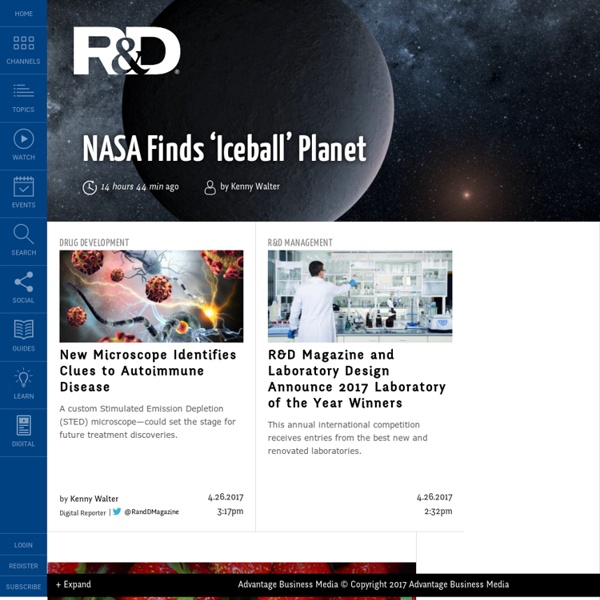



The Conversation: In-depth analysis, research, news and ideas from leading academics and researchers. Science Daily: News & Articles in Science, Health, Environment & Technology Science and technology research news | R&D Projects « Prev | 1 | 2 | 3 | 4 | 5 | 6 | 7 | 8 | 9 | 10 | Next » Detecting corrosion and fatigue during service A new project, CORFAT (Cost effective corrosion and fatigue monitoring for transport products SCP7-GA-2008-218637), looks to develop new monitoring technology based on acoustic emission testing (AT) combined with follow-up NDT (non-destructive testing) to detect defects such as corrosion or cracks in the structure of surface transport products (ships, railway tank cars, road tankers). Projects talks to Andreas Jagenbrein about predictive maintenance and what this means for transport safety. Read more » Human microbiota interactomics and multidisciplines The human body contains around ten times as many bacterial cells than it does human cells, and this gut microbiota provides the body with many useful metabolic functions. Read more » Computing the cure Read more » Tackling Quantum’s Classic Riddles Read more » Biosensing device research: the benefits of working together Read more » Read more »
DigInfo TV Accelerating Future There isn’t enough in the world. Not enough wealth to go around, not enough space in cities, not enough medicine, not enough intelligence or wisdom. Not enough genuine fun or excitement. Not enough knowledge. Not enough solutions to global problems. What we need is more . There is a bare minimum that we should demand out of the future. 1) More space 2) More health 3) More water 4) More time 5) More intelligence First off, we need more space . There is actually a lot of space on this earth.
PLoS Biology : Publishing science, accelerating research A Peer-Reviewed, Open Access Journal Current Issue PLOS Biology is a peer-reviewed, open-access journal featuring research articles of exceptional significance in all areas of biological science, from molecules to ecosystems. Public Library of Science: Open Access The Case for Open Access Open Access (OA) stands for unrestricted access and unrestricted reuse. Here’s why that matters. Most publishers own the rights to the articles in their journals. Although many researchers can access the journals they need via their institution and think that their access is free, in reality it is not. Paying for access to content makes sense in the world of print publishing, where providing content to each new reader requires the production of an additional copy, but online it makes much less sense to charge for content when it is possible to provide access to all readers anywhere in the world. PLOS Takes a Different Approach PLOS applies the Creative Commons Attribution (CC BY) license to works we publish. Benefits of Open Access Research Accelerated discovery. Additional OA Resources
Science News, Articles and Information | Scientific American Tietysti Kuukauden tutkija Auringon hiukkassade vaikuttaa ilmakehään Akatemiatutkija Annika Seppälä haluaa saada ilmastomalleihin niistä puuttuvan paikallisissa mittakaavoissa oleellisen tiedon – sen, miten Auringosta tulevat hiukkaset vaikuttavat ilmakehän kemialliseen koostumukseen. Lue lisää » Videoblogit Suomalaisen peliteollisuuden kahdet kasvot Pelaaminen on hauskaa, pelintekijät ovat superstaroja ja kansantalouskin kiittää. Kannattaa tutustua Ikuisesti yhdessä – kaksoishautausten tulkintaa Suomessa hautaustapojen tutkimus on aiemmin keskittynyt pääasiassa polttohautauksen ja ruumishautauksen toisistaan erottamiseen, haudan rakenteisiin sekä hauta-antimien tulkintaan. Taiteen kautta mielen ja luovuuden tutkimukseen Mitä aivoissamme tapahtuu, kun opimme uuden käsityötaidon? Miten alkoholi ja tupakka vaikuttavat aivoihin ja kehoon? Ylilääkäri Antero Heloma, dosentti Petri Hyytiä vastaavat ja professori Urho Kujala vastaavat. Tapahtumakalenteri Tiedotteet SivukarttaMediatiedot
44 tips cards for photographers to cut out and keep or browse on your phone! Digital Camera magazine has been putting pop-out tips cards on its covers for dozens of issues (find out how to subscribe below), so we thought why not put our favorites online? We've picked out a selection of cards to keep you busy during the coronavirus crisis, and they include camera theory, tips for portraits and people shots, ideas for things to photograph in the garden and little projects you can tackle at home. They've been sized specially for easy on-screen viewing, and not just on a desktop computer but on the smaller screen of a tablet or a smartphone. For those who prefer paper to pixels, see our diagram below. Need a printer? • The best all-in-one printer for home working • The best photo printer right now • The best portable printer for photos Download and print 1. 2. 3. 4. 5. Nature in the garden People and portraits Home projects Camera theory Digital Camera magazine Alternatively, we have a number of different digital options available, including: Need a printer? 1. 2. 3. 4. 5.